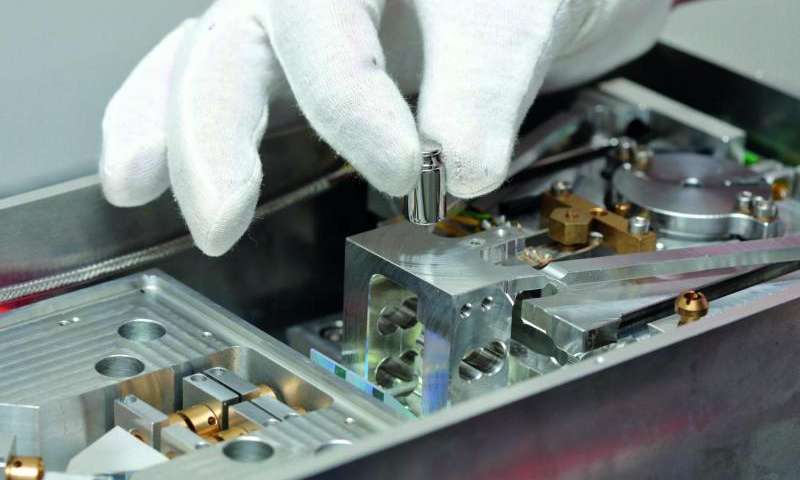
(Credit: Credit: TU Ilmenau)
Technische Universität Ilmenau and the Physikalisch-Technische Bundesanstalt (the National Metrology Institute of Germany) are developing a balance which is required for measuring the redefined kilogram that will be introduced in 2018. Called the Planck balance, this highly precise electronic weighing balance is not based on weights, but refers to the fundamental physical constant called Planck’s constant. The balance will be used worldwide for calibrating other scales or balances so that they correspond to the system with this new method. The new balance will also be used in industry for measuring weights.
In many sectors, there is a significant demand for highly precise balances, including pharmaceutical companies for precise dosing of medical products, in official metrology service labs for calibrating scales for food, and in police departments, for the proof of toxic substances and in ballistics.
The original kilogram, a four cm cylinder made from platinum and iridium and stored under three glass domes in a safe near Paris since 1889, is becoming lighter. Over 100 years, it has lost 50 millionths of a gram. As all scales worldwide refer indirectly to this unique kilogram, they all weigh incorrectly, even if by minimal and negligible amounts. Although the original kilogram is becoming lighter, structurally identical copies of the prototype are used worldwide – which means that these copies are slowly becoming heavier relative to the prototype. Therefore, a new standard is required that does not change and cannot be damaged or lost.
In 2018, the new kilogram will be adopted at the 26th General Conference on Weights and Measures. It is not defined by an object or a physical mass, but by Planck’s constant. The highly precise, continuously measuring Planck balance, developed by the German university Technische Universität Ilmenau, operates on the principle of electromagnetic force compensation. Simply put, a weight on one side is to be balanced by electrical force on the other. This electrical force is inextricably linked with the Planck’s constant and can be directly referred to the new kilogram definition. As this balance is the first self-calibrating instrument of its kind, masses determined as reference or standard masses for calibrating scales and balances are no longer required. Another advantage of the Planck balance is its wide measuring range, from milligrams to one kilogram. At the end of the year, the first prototype of the balance will be available and ready for use.
Knowledge gained over the last decade on the basis of the development of the so-called 1-kg-prototype mass comparator was the direct key for research work in the field of the Planck balance. This highly precise mass comparator is already used in national metrology institutes all over the world for the comparison of kilogram-prototypes.
For redefining the kilogram on the basis of physical constants, two approaches are considered worldwide: the Avogadro experiment, where in an almost perfect crystal, the number of atoms was determined in a sphere of isotopically pure silicon. The second approach refers to the Watt balance. Similar to the Planck balance, it compensates the weight force of a mass in the Earth’s gravitational field by an electromagnetic force. For both experiments the Planck’s constant is determined so that the two approaches meet at the target. The Physikalisch-Technische Bundesanstalt has primarily chosen the silicon sphere, while other metrology institutes, e.g. the U.S. National Institute of Standards and Technology (NIST) and the Canadian National Research Council (NRC), favor the Watt balance. For supplying the industry with balances meeting both standards in the future, the PTB has developed together with the TU Ilmenau the Planck balance as the industry-compliant version of the Watt balance.


